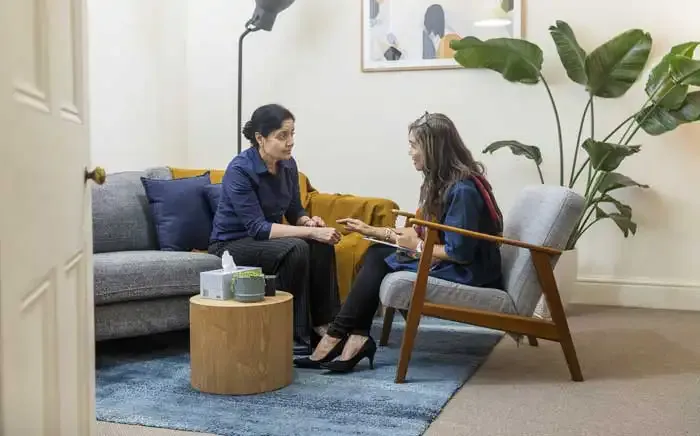Who can help manage my chronic pain?

Chronic pain can be an isolating experience.
People with chronic pain often receive the same approach to treatment that would be applied to acute (short-term) pain. But this is generally not effective.14
Treatment that only focuses on reducing your pain in the short-term is not the most effective approach.
A more achievable aim is to slowly reclaim your functioning, without making your pain worse.12
Pain Australia recommends a multidisciplinary pain management plan that includes a combination of medical approaches, physiotherapy, and psychological treatment.15
This would likely mean seeing a number of health professionals which may include:
- doctors
- nurses
- psychologist
- psychiatrist
- exercise physiologist
- physiotherapist
- occupational therapist
- pharmacist
- dietitian
- social worker or counsellor.12,15
Multidisciplinary pain management can be provided by pain management clinics.
A pain management clinic is a health care practice that specialises in the treatment and management of chronic pain.
These multidisciplinary pain services can be offered through the community, public hospitals, or private services. Depending on the service, you can attend an inpatient or outpatient program.
Typically, however, most pain care is delivered and maintained by GPs (doctors) and other non-pain specialists.16
People consider meaningful relief from chronic pain has been achieved when their pain intensity is reduced by at least 50%. Most patients achieve this through a multidisciplinary approach, not solely through medicines, such as opioids.16, 17
It’s best to ask your GP about which pain management options are suitable for you. This will also involve self-management options - but more on that later.
How do I get an appointment with a pain management clinic?
Your doctor will need to give you a referral to a pain management clinic.
You can find your local clinic by asking your GP or referring doctor, or through the National Pain Services Directory.
Your doctor’s referral should note if you are eligible for compensation of services through Transport Accident Commission (TAC) or WorkSafe.
You should also check with the pain management clinic to see what documentation and information they need, as this can vary depending on the hospital, state, or territory. For example, this is the Victorian Statewide Referral Criteria which gives you an idea of what information your clinic might need.
Once your referral has been accepted, you will typically be asked to complete a questionnaire about the impact of pain on your daily life. Then, you’ll likely get an appointment to discuss expectations and needs.
You may also have a medical assessment.
Some clinics require evidence of:
- previous treatment in the past 12 months, such as exercise or pain medication
- impact on daily activities, including work, study, school, or carer role
- being at risk of medication dependence, or physical or mental decline
- adequate trial of self-management options.
After your initial assessment, you may be assessed by the multidisciplinary team and/or a medical pain specialist. A report will then be sent to you and your referring doctor with the assessment outcomes and pain management recommendations.
Depending on your individual needs and availability of local services, you may be placed on a waiting list before treatment begins.
In some cases, people seek out pain management privately if they can afford it.
Throughout the process, clinic staff and your referring doctor will support you and let you know the next steps.18,19,20
What treatments are available?
If you’re eligible for services at a pain management clinic, your team will use a range of approaches to create a unique treatment plan for you.
These can vary depending on the clinic, your pain, and your personal goals, but types of pain treatment include:
- psychological therapy such as cognitive-behavioural therapy (CBT), acceptance and commitment therapy (ACT), and family therapy
- relaxation techniques such as meditation, mindfulness, and yoga
- exercise that helps achieve your desired wellness, physical, and functional goals
- self-management education through individual and/or group programs that aim to reduce stress and promote self-confidence in dealing with pain
- support groups
- pain medication
- joint blocks - an injection of anaesthetic and steroid that is used to diagnose and treat joint pain
- nerve blocks - a specialised injection that targets a certain nerve or group of nerves to help diagnose and treat nerve pain
- radiofrequency ablation (or RFA) - treatment that targets joint and nerve pain to interrupt the nerves that transmit pain signals to your brain
- spinal cord stimulation – a pain treatment that sends an electrical impulse to the spinal cord to block the pain signals to your brain. This treatment is used for persistent nerve pain.
- IV infusions of pain relief medications that help manage certain chronic pain
- platelet rich plasma injections (PRP injection/therapy) that are designed to accelerate your natural healing process of musculoskeletal injuries.21,22,23,24
It’s important to remember pain specialists and pain management clinics are not the only options for multidisciplinary care.
You can ask your GP to connect you with services that offer some of the above treatments, outside of pain management clinics.